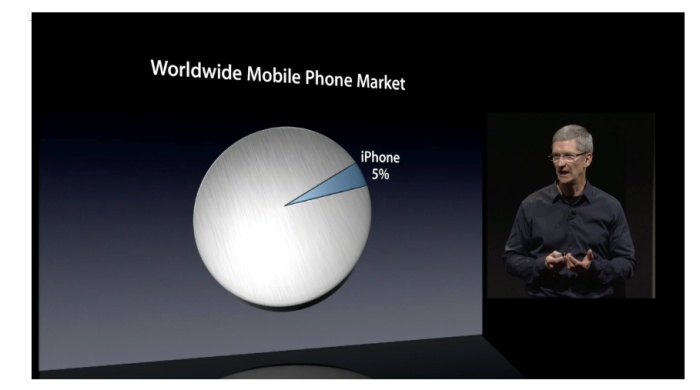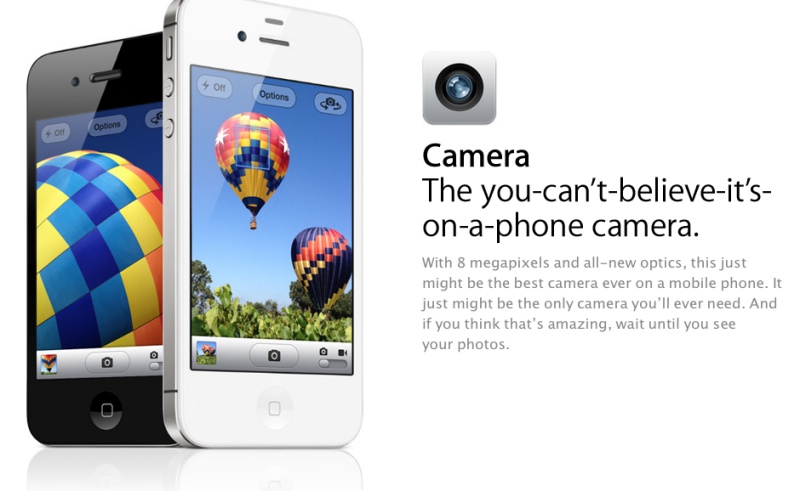The demise of point-and-shoot cameras.
Watching Tim Cook’s roll out of the iPhone 4S this past Tuesday, I was struck by this slide:

A typical, disingenuous presenter would have taken the simple way out – shown the iPhone as having some 30-50% share of the smartphone market. Cook was more honest. 5% is the iPhone’s share of the global cell phone market, he stated, and the reason we are showing the statistic that way is that we believe eventually every cell phone user will be a smartphone user.
That seems right. One of the unremarked, yet very significant, features of the latest iPhone, the 4S, is that for the first time no computer is required to use it. Most of the world’s citizens still do not own a computer. Most wish they did. Now the iPhone comes to you with over the air start-up and maintenance, including back-up and remote storage. No computer is required. It is a computer. You might say that the iPhone is the computer for the rest of the world much as the Macintosh was the Computer for the Rest of Us all those years ago.
I ordered the new iPhone 4S as soon as the online page to do so became available. There are several reasons, but the most important is that I am a huge fan of the process of early adoption of new technologies. For those who are always waiting for Version 2 of anything, the cheaper, debugged one, I say “Your time is worth little and you value your life even less”. Every day represents a higher percentage of my remaining time on earth and that means a lot to me. The math is the same for the late adopter, the result different.
I set forth my beliefs concerning early adoption in The Unfair Advantage. Later, writing about Steve Jobs’s last days as CEO of Apple I stated:
“Transduction is increasingly a matter of speech and touch rather than hitting idiotically disposed keys on keyboards designed around the mechanical limitations of a bygone age. ”
That day is rapidly approaching and the first likely usable realization for the man in the street will be the Siri voice recognition technology in the iPhone 4S. The keyboard’s days are finally numbered. I was especially attracted to the use of the new phone with Wikipedia. I encourage our son to do his homework using Wikipedia on the iPad. Now he will no longer have to type his query. He will just speak it. And I very much want to confer the Unfair Advantage this suggests upon him. Remember how Jobs showed the very first iPhone to a friend and asked him what he thought, only to be met with the reply “You had me at scrolling!”? Well, the iPhone 4S had me at Siri.
So as Apple and Android continue to do a number on dumbphones, Apple has just announced the death of the worst possible thing about computing, the keyboard.
But there’s another nascent seismic change in the iPhone 4S, and in other better smartphones, and that’s the new Sony 8mp camera. Now, goodness knows, I’m no fan of small sensors. After all, I really like large prints and small sensors don’t cut it there – yet. Meanwhile, we have foolish efforts by the likes of Nikon and Fuji who are making cameras with miniscule sensors at less than miniscule prices. Given that everyone has to have a phone and as every smartphone comes with a camera with a like sized sensor, why on earth would you shell out $600-1,000 on these short lived toys when you can get much the same capability in your phone? And the iPhone’s Sony camera boasts some non-trivial features, features to which Apple devoted very substantial time in its product roll out this week:

Click the picture for the feature list.
With improving ergonomics – no need to switch the phone on to take a snap, under 0.5 seconds from snap to snap, a better disposed shutter button (the latest iOS variant allows the use of the side/top mounted volume buttons to take a picture), better definition, high battery life, HDR, 1080p movie mode, vibration reduction and so on – you get a lot of what the designers looking in the rear view mirror at Nikon and Fuji want to charge you $700 for. Plus, at the touch of an icon my iPhone snaps will be in the cloud, available on all my devices. No upload/download/frustration cycle to deal with and you always have a decent camera with you. And unlike the tired offerings of the camera makers, when you upgrade your iPhone two years hence at no cost, selling the old one for a profit to some Eastern European, its replacement will come with an even better camera while your Fujikcanon rots in the desk drawer, obsolete and worthless, aired annually at Christmas.
So the nascent technology in the latest generation of smartphones will not only kill the keyboard. If I were a manufacturer of point-and-shoot mass market cameras, where I make my bread and butter, I would be seriously scared and looking for new directions in my business. And I already know that I can only sell so many large sensor behemoths to the ‘serious’ crowd, allowing me to downmarket to the rest. The point-and-shoot camera’s demise was announced this week, coinciding neatly with Kodak’s impending bankruptcy.
Stay tuned here for my experiences with the camera in the iPhone 4S, which I should have in a few days. My tired old iPhone 3G? It’s already programmed for use as a universal wireless remote. Ivan can buy his elsewhere.
Can cell phones take pictures? Wrong question. Photographers take pictures.
Disclosure: Long AAPL call options.
I preordered one too in the end.